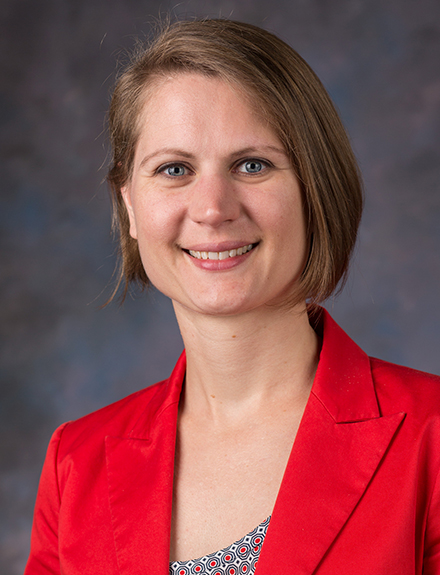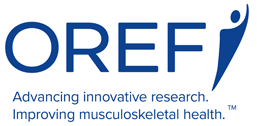

Amanda T. Whitaker, MD
Research Topic
Investigated the effect the protein Smad 4 has on cell polarity, which affects the growth plate and, therefore, bone growth.
Patient Impact
Better understanding of the signaling mechanisms of the growth plate and how disturbances affect its form and function. This may later be used in cartilage engineering.
Form and Function
OREF grant recipient investigates chondrocyte polarity and growth plate genesis
Jay D. Lenn, OREF contributing writer
The modernist architecture principle of form follows function promoted the idea that the design of a building depended on how it would be used. It’s a useful, if imperfect, analogy for understanding cell polarity—a certain cellular form is required for a particular cellular function.
The architecture of growth plates—the cartilage near the end of long bones where bone growth occurs—requires well-regulated cell polarity. The growth plate (physis) is composed of distinct layers of a single type of cell, chondrocytes, but in each layer, cells are transformed—in shape, size, orientation, and internal organization—so that they function differently. If this well-regulated cell polarity is disrupted, cells do not function properly and the growth plate does not produce healthy bone growth.
Amanda T. Whitaker, MD, has investigated the effect of a protein called Smad4 on cell polarity. With studies of a mouse model of Myhre syndrome, a rare form of skeletal dysplasia, she has begun characterizing the intracellular events that regulate chondrocyte polarity and physis morphogenesis.
Dr. Whitaker’s work was funded in part by a 2013 Orthopaedic Research and Education Foundation (OREF) Resident Clinician Scientist Training Grant, made possible by the Ira A. Roschelle Family Foundation, while she was in residency at the University of California, San Francisco. Currently, she is a faculty member in the department of orthopaedic surgery at Nationwide Children’s Hospital in Columbus, Ohio. The 1-year OREF grant awards $20,000 with the goal of preparing a resident for a career with research as a major component.
Modeling defects in growth plate architecture
Myhre syndrome is a rare genetic disorder that results in growth plate defects, short stature, short fingers and toes, and other skeletal abnormalities, as well as defects in other body systems. Myhre syndrome is caused by a mutation in the gene that encodes Smad4, the key player in a protein complex that transmits a signal from growth factors docked on a cell surface to the cell nucleus for initiating the transcription of particular genes.
A mouse model of Myhre syndrome with an altered Smad4 gene replicates the skeletal features of the disorder and the growth plate defects.
“I’m looking at how the mutation in the Smad4 gene changes the cell signaling pathway and the polarity of these chondrocytes because, in each layer of the growth plate, the chondrocytes have a very specific shape and very specific role,” Dr. Whitaker explained.
Chondrocytes produce proteoglycans and collagens that form the cartilaginous matrix of the growth plate. In the resting zone (closer to the ends of a long bone), the small, round chondrocytes are irregularly organized. In the next zone, the proliferative zone, the cells become flattened into an elliptical disk shape, undergo rapid mitosis, and arrange themselves in columns. In the hypertrophic zone, the cells do not replicate, but they grow longer and larger. They also begin to release proteins that promote calcification. And in the fourth zone of calcification, the chondrocytes undergo apoptosis and the matrix becomes calcified to form new bone.
Dr. Whitaker explained that the growth plates in the mouse model exhibit “broad, short chondrocyte columns and randomly oriented proliferating chondrocytes that distort the direction of growth."
Characterizing changes in chondrocyte polarity
The OREF grant supported the following three research aims:
- To characterize the effect of Smad4 deficiency on chondrocyte polarity by quantifying cell shape, cell division, and intracellular organelle localization in mouse model tibial growth plates.
- To examine the effects of Smad4 deficiency on the activation of proteins believed to play a role in cell polarity.
- To manipulate levels of Smad4 and an associated transmembrane protein in vitro to probe their functional interactions in the control of chondrocyte polarity.
This investigation provided a foundation for additional grants from the National Institutes of Health and other funding organizations. In March 2017, Dr. Whitaker and her colleagues published their results in Biology Open 1. They reported that Smad4 deficiency decreased proteoglycan production, increased Matrix metalloproteinase-13 (MMP13) production, and disrupted the normal balance of matrix synthesis and degradation. They observed defects in chondrocyte polarity, including impaired proliferation and impaired ability to change shape, size, and orientation in the different zones of the growth plate architecture.
"Understanding the role of Smad4 and its molecular partners is relevant not only to understanding mechanisms contributing to skeletal dysplasia, but also to elucidating the fundamental mechanisms that regulate growth plate formation and cell polarity,” Dr. Whitaker said. “Future clinical implications might include new directions in research with tissue engineering to recreate cartilage for treating growth disturbances after trauma, biologic limb lengthening, or deformity correction."
Funding research, enabling careers
Dr. Whitaker noted that the OREF grant was critical not only in funding her initial investigations but also in promoting her development as a clinician scientist.
“Rather than simply working on an established research project during my residency, the grant gave me ownership. It enabled me to be the principle investigator, manage the budget, coordinate experiments, lead a team, and decide next steps in research,” she stated.
In addition, the mentorships and early collaborations in research under the OREF grant provided Dr. Whitaker with the foundation for ongoing collaborations. “Without the OREF funding, I don’t think the research during my residency would have been such a rich experience,” she said.
Jay D. Lenn is a contributing writer for OREF. He can be reached at communications@oref.org.
1. Whitaker AT, Berthet E, Cantu A, Laird DJ, Alliston T. Smad4 regulates growth plate matrix production and chondrocyte polarity Biol Open. 2017 Mar 15;6(3):358-364. doi: 10.1242/bio.021436.PMID:28167493
